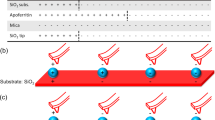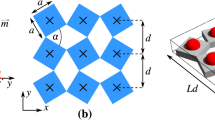Abstract
A key issue in research on ferrofluids (dispersions of magnetic colloids) is the effect of dipolar interactions on their structure and phase behaviour1,2, which is not only important for practical applications3 but gives fundamental insight in dipolar fluids in general. In 1970, de Gennes and Pincus4 predicted a Van der Waals-like phase diagram and the presence of linear chains of particles in ferrofluids in zero magnetic field. Despite many experimental studies5,6,7, no direct evidence of the existence of linear chains of dipoles has been reported in the absence of magnetic field, although simulations8,9,10,11 clearly show the presence of chain-like structures. Here, we show in situ linear dipolar structures in ferrofluids in zero field, visualized on the particle level by electron cryo-microscopy on thin, vitrified films of organic dispersions of monodisperse metallic iron particles. On systematically increasing the particle size, we find an abrupt transition from separate particles to randomly oriented linear aggregates and branched chains or networks. When vitrified in a permanent magnetic field, these chains align and form thick elongated structures, indicating lateral attraction between parallel dipole chains. These findings show that the experimental model used is well suited to study the structural properties of dipolar particle systems.
This is a preview of subscription content, access via your institution
Access options
Subscribe to this journal
Receive 12 print issues and online access
$259.00 per year
only $21.58 per issue
Buy this article
- Purchase on Springer Link
- Instant access to full article PDF
Prices may be subject to local taxes which are calculated during checkout


Similar content being viewed by others
References
Teixeira, P.I.C., Tavares, J.M. & Telo da Gama, M.M. The effect of dipolar forces on the structure and thermodynamics of classical fluids. J. Phys. Condens. Matter 12, R411–R434 (2000).
Tlusty, T. & Safran, S.A. Defect-induced phase separation in dipolar fluids. Science 290, 1328–1331 (2000).
Berkovski, B. & Bashtovoy, V. (eds) Magnetic Fluids and Applications Handbook (Begel House, New York, 1996).
de Gennes, P.G. & Pincus, P.A. Pair correlations in a ferromagnetic colloid. Phys. Kondens. Mater. 11, 189–198 (1970).
Shen, L., Stachowiak, A., Fateen, S.K., Laibinis, P.E. & Hatton, T.A. Structure of alkanoic acid stabilized magnetic fluids. A small-angle neutron and light scattering analysis. Langmuir 17, 288–299 (2001).
Donselaar, L.N. et al. Visualisation of particle association in magnetic fluids in zero-field. J. Magn. Magn. Mater. 201, 58–61 (1999).
Cebula, D.J., Charles, S.W. & Popplewell, J. Aggregation in ferrofluids studied by neutron small angle scattering. J. Physique 44, 207–213 (1983).
Weis, J.J. Orientational structure of quasi-two-dimensional dipolar hard spheres. Mol. Phys. 93, 361–364 (1998).
Tavares, J.M., Weis, J.J. & Telo da Gama, M.M. Strongly dipolar fluids at low densities compared to living polymers. Phys. Rev. E. 59, 4388–4395 (1999).
Chantrell, R.W., Bradbury, A., Popplewell, J. & Charles, S.W. Agglomerate formation in a magnetic fluid. J. Appl. Phys. 53, 2742–2744 (1982).
Tavares, J.M., Weis, J.J. & Telo da Gama, M.M. Quasi-two-dimensional dipolar fluid at low densities: Monte Carlo simulations and theory. Phys. Rev. E. 65, 061201 (2002).
Massart, R. Preparation of aqueous magnetic liquids in alkaline and acidic media. IEEE Trans. Magn. 17, 1247–1275 (1981).
Rosensweig, R.E. Ferrohydrodynamics (Cambridge Univ. Press, Cambridge, 1985).
Griffiths, C.H., O'Horo, M.P. & Smith, T.W. The structure, magnetic characterization, and oxidation of colloidal iron dispersions. J. Appl. Phys. 50, 7108–7115 (1979).
Talmon, Y. Transmission electron microscopy of complex fluids: The state of the art. Ber. Bunsenges. Phys. Chem. 100, 364–372 (1996).
Frederik, P.M., Stuart, M.C.A., Schrijvers, A.H.G.J. & Bomans, P.H.H. Thin film formation and the imaging of phospholipids by cryo-electron microscopy. Scanning Microscopy 3, 277–284 (1989).
Oostergetel, G.T., Esselink, F.J. & Hadziioannou, G. Cryo-electron microscopy of block copolymers in an organic solvent. Langmuir 11, 3721–3724 (1995).
Pathmamanoharan, C., Zuiverloon, N.L. & Philipse, A.P. Controlled (seeded) growth of monodisperse sterically stabilised magnetic iron colloids. Progr. Colloid Polym. Sci. 115, 141–145 (2000).
Goossens, A. et al. Monodisperse magnetic iron colloids grafted with polyisobutene: a model system for Fischer-Tropsch catalysts? Hyperfine Interact. 141/142, 381–386 (2002).
Scholten, P.C. in Magnetic Properties of Fine Particles (eds. Dormann, J.L. & Fiorani, D.) 277–286 (Elsevier, Amsterdam, The Netherlands, 1992).
Reimer, L. Transmission Electron Microscopy: Physics of Image Formation and Microanalysis 2nd edn Vol. 36 (Springer, Heidelberg 1989).
Fannin, P.C., Scaife, B.K.P. & Charles, S.W. New technique for measuring the complex susceptibility of ferrofluids. J. Phys. E. 19, 238–239 (1986).
Fermigier, M. & Gast, A.P. Structure evolution in a paramagnetic latex suspension. J. Magn. Magn. Mater. 122, 46–50 (1993).
Gast, A.P. & Zukoski, C.F. Electrorheological fluids as colloidal suspensions. Adv. Colloid Interface Sci. 30, 153–202 (1989).
Skjeltorp, A.T. One- and two-dimensional crystallization of magnetic holes. Phys. Rev. Lett. 51, 2306–2309 (1983).
Halsey, T.C. Electrorheological fluids. Science 258, 761–766 (1992).
Osipov, M.A., Teixeira, P.I.C. & Telo da Gama, M.M. Structure of strongly dipolar fluids at low densities. Phys. Rev. E. 54, 2597–2609 (1996).
van Ewijk, G.A., Vroege, G.J. & Kuipers, B.W.M. Phase behavior of magnetic colloid-polymer mixtures: 2. A magnetic sensing coil study. Langmuir 18, 382–390 (2002).
Frederik, P.M., Bomans, P.H.H., Laeven, P.F.J. & Nijpels, F.J.T. Device for Preparing Specimens for a Cryo-electron Microscope (Netherlands Industrial Property Office (RO/NL) PCT/NL02/00189 2002).
Oldenbourg, H. & Philips, W.C. Small permanent magnet for fields up to 2.6 T. Rev. Sci. Instrum. 57, 2362–2365 (1986).
Acknowledgements
Marc Storms and Felix de Haas from FEI Electron Optics, Eindhoven, The Netherlands, are thanked for performing the EELS-measurements. Ben Erné and Thido Arts are thanked for their help with the susceptibility measurements. Financial support was granted by the Dutch Technology Foundation (STW) with financial aid from the Council for Chemical Science of the Netherlands Organization for Scientific Research (CW/NWO).
Author information
Authors and Affiliations
Corresponding author
Ethics declarations
Competing interests
The authors declare no competing financial interests.
Rights and permissions
About this article
Cite this article
Butter, K., Bomans, P., Frederik, P. et al. Direct observation of dipolar chains in iron ferrofluids by cryogenic electron microscopy. Nature Mater 2, 88–91 (2003). https://doi.org/10.1038/nmat811
Received:
Accepted:
Published:
Issue Date:
DOI: https://doi.org/10.1038/nmat811
This article is cited by
-
Adaptive iron-based magnetic nanomaterials of high performance for biomedical applications
Nano Research (2022)
-
The effect of the magnetically dead layer on the magnetization and the magnetic anisotropy of the dextran-coated magnetite nanoparticles
Applied Physics A (2022)
-
Magnetic-programmable organohydrogels with reconfigurable network for mechanical homeostasis
Nano Research (2021)
-
Magnetic field-induced self-assembly of chemically modified graphene oxide on cellulose fabrics for the fabrication of flexible conductive devices
Cellulose (2021)
-
Study about the structure and dynamics of magnetic nanofluids using a mesoscopic simulation approach
Nonlinear Dynamics (2018)



